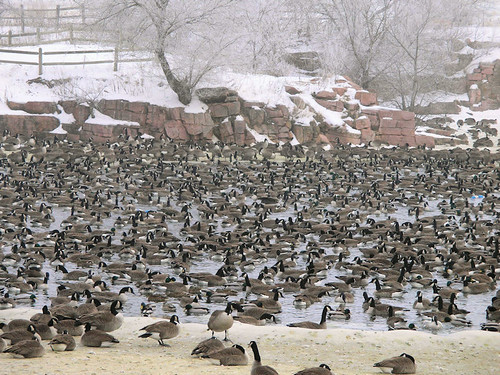Sometimes it’s time to stop and step in the goose poop.
That’s what I did a couple of days ago.

“Geese” CC image courtesy of Martin Weller on Flickr. Noncommercial license.
I needed to get out of the house. There comes a point every day where I go stir crazy. Not mildly stir crazy. Not something that five minutes’ stroll around the block will cure. But mountain-climbing-sweating-like-a-buffalo-running-5K-with-no-warmup crazy.
By that point in the day — and it seems to arrive about the same time every day — I’ve been working on the computer for hours. It might be for a client or it might be my own writing… or I might’ve procrastinated all day on social media, compulsively following one interesting link to the next.
The onset is usually sudden. One moment, I’m hunched over the table, nose inches from the computer monitor — atrocious posture is a good sign that things need to change — the next, I’m literally pacing my apartment, fantasizing about sprinting through the city streets.
Then it dawns on me that I could solve everything if I just Got Outside.
Thus it is I found myself Outside at Sloan Lake in Northwest Denver last week. Like most Denver city parks I’ve seen, Sloan Lake has been appropriated by hordes of Canadian geese. And they’ve left many mementos of their presence.

“Geese” CC image courtesy of Overduebook on Flickr. Attribution license.
The last time I remember seeing this many geese in one place was at the county park in New Jersey where my high school track team trained. A paved path made up the outside perimeter of the park, shaped like a sloppy figure eight. Inside each loop was a large grassy area. The inside of the south loop was essentially one big meadow, but the north loop featured a number of sports fields: the de facto soccer pitches, a baseball diamond and field, the throwing cage and field for discus and javelin, the 400 meter track. The geese came in large numbers in the winter, and then they seemed never to leave. Long before experts decided to reclassify the Canadian goose as a non-migratory bird, those of us on the track team were well aware of their sedentary ways.
So it is at Sloan Lake.
The circuit around the lake is a paved walkway. On either side of the walkway, winter-deadened grass an indeterminate color somewhere between yellow, beige, and brown spans the grounds of the park. It is the perfect color for goose poop camouflage.
Generally, I prefer running on unpaved surfaces because it’s nicer on the joints. However, the advantage to the walkway at Sloan Lake is that it’s possible to ascertain where the goose poop is, and whether or not you are stepping in it. Usually you are… the walkway is a veritable minefield. But it’s where I started, in a vain effort to keep the bottoms of my shoes poop-free.
The area around the lake affords park visitors a clear view to the Rocky Mountains. In between dodging little green-brown-yellow minefields, I noticed that clouds were spreading in a bank above the peaks, although the rest of the sky was cloudless. The sun was low, first behind the clouds and then dipping behind the mountains, which became mere silhouettes. I kept losing my pace because I had to turn my head and look. The light was transparent and yet gold at the same time, and the frozen lake was very blue. Some geese had settled on an open stretch of water to the west, and they looked serene, even appropriate.
As I completed my circuit on the eastern shore, I looked back across the snowy landscape to the dusk coming down from the mountains. The clouds separated two identical color sequences above the tops of the highest peaks: mountains, gold, pink, blue; clouds, gold, pink, blue.
A cacophony of honking and the squeak of wings behind me heralded a flyover. I turned and ducked, afraid that at least one of them would go potty as they passed overhead. Instead, they flew past me without incident and curved out over the lake, in a long line from north to south, easily more than 50 birds together. They became a dark band against the bluing western sky as they went, an eyebrow between the lake and the clouds. The honking and creaking faded, and I was left with a feeling of joy in their passing, their being there at that moment, the way they graced the sky — truly in their element.
That was worth stepping in some goose poop.
=== ===
Do you ever feel a sudden need to change your surroundings? What unexpected beautiful things did you discover as you went?








